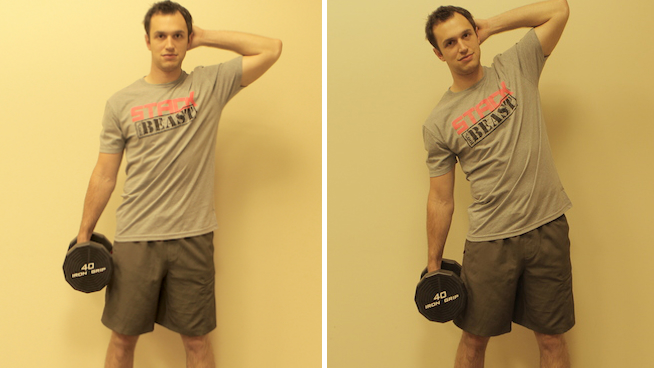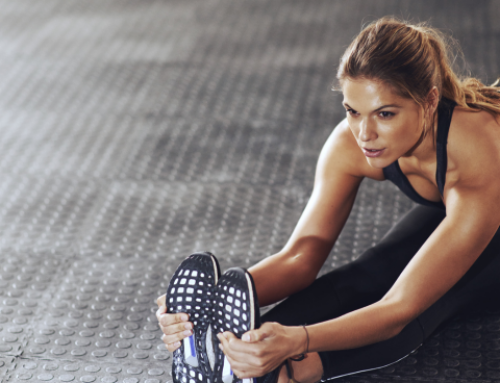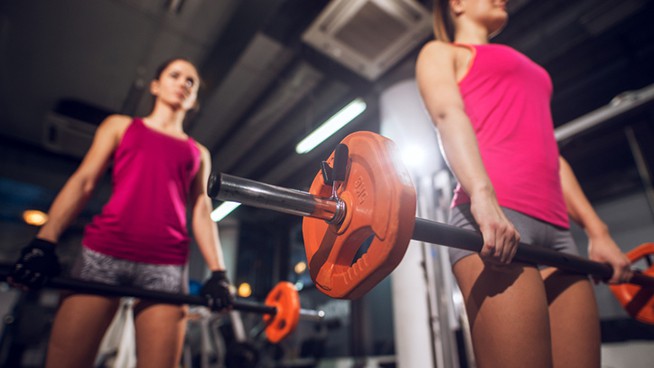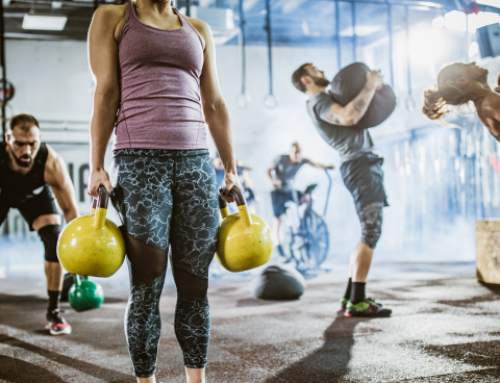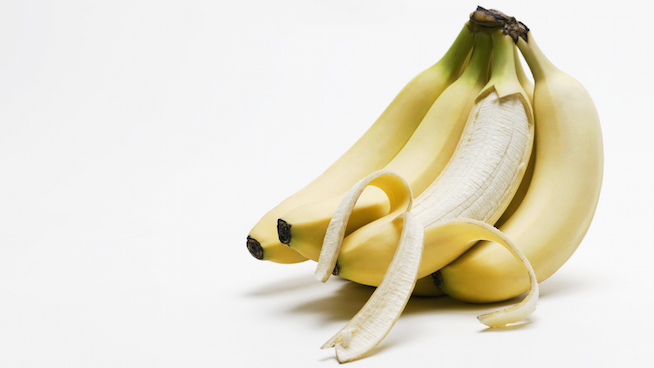Training Trash Bin: Dumbbell Side Bends
An exercise may be popular, but that doesn’t mean it’s effective. This is the case with the Dumbbell Side Bend, an old-school oblique exercise you should remove from your repertoire and send it to the Training Trash Bin.
There’s a good chance you’ve seen this exercise if you’ve spent time in your local fitness center. As a refresher, it looks like this:
It’s a simple move that people do to work their obliques. But, it’s a waste of your valuable time in the gym. Here’s why:
You Tilt Your Torso Awkwardly to the Side
The Dumbbell Side Bend looks awkward. That’s because it is. Pat Downey, founder of Vantedge Performance (Woburn, Massachusetts), explains that lateral spinal flexion puts your spine in a vulnerable position, especially when you’re holding a heavy weight. It’s best to avoid this movement so you don’t put stress on your back—similar to why you should also avoid Sit-Ups and Crunches.
It Trains Your Core the Wrong Way
Your core muscles are designed to resist movement, not create it. “The core muscles are anti-movers and work to stabilize the spine while the appendages move,” Downey says. The core’s bracing effect protects your spine and helps transfer power between your lower and upper body, like when you throw a ball or swing a bat. The Dumbbell Side Bend takes you through a range of motion that is limited to that specific exercise. You rarely, if ever, tilt your upper body to the side in this fashion in sports or daily life.
It Doesn’t Spot Reduce
Dumbbell Side Bends will not reduce fat on the sides of your belly. It’s impossible to spot-treat specific areas of the body. The only way to lose belly fat is to follow a complete workout program supported by a balanced diet. Also, if you’re trying to improve your figure, Dumbbell Side Bends may actually broaden your stomach.
It’s Easy
Moving a dumbbell up and down over a few inches hardly qualifies as a challenging exercise—maybe that’s why it’s popular.
Other Options
Building strong obliques is an important part of developing your core. Fortunately, there are many more effective exercises to choose from that target these muscles. “The best way to build your obliques and core are through stabilization and isometric movements,” Downey asserts.
Dumbbell Suitcase Carries
When you do Dumbbell Suitcase Carries, rather than tilting your torso, you hold a dumbbell to your side and walk while keeping your torso upright. This builds your obliques and increases overall core stability.
How to: Hold a dumbbell with one hand at your side. Keeping your chest up and your abs tight. Walk forward for a specified time or distance.
Sets/Distance: 3×20-25 yards each side
Side Planks
The Side Plank is the most basic, but highly effective, exercise you can perform to work the core muscles on the side of your body.
How to: Lie on your side with your elbow positioned under your shoulder and your forearm flat on the ground. Raise your hips so your body is in a straight line; hold this position for the specified duration.
Sets/Duration: 3×30 sec. each side
Pallof Press
An anti-rotation exercise, this movement trains the same muscles you use during the Side Bend, but in a way that’s more functional to sports performance and injury prevention.
How to: Stand with your feet hip-width apart and position your body perpendicular to a cable machine. Grasp the cable handles with both of your hands at your chest. Keeping your core tight, extend your arms in front of your chest; hold for two counts. Bend your arms to return to the starting position.
Sets/Reps: 3×10 each side
RELATED: Why You Should Never Do Leg Extensions
RECOMMENDED FOR YOU
MOST POPULAR
Training Trash Bin: Dumbbell Side Bends
An exercise may be popular, but that doesn’t mean it’s effective. This is the case with the Dumbbell Side Bend, an old-school oblique exercise you should remove from your repertoire and send it to the Training Trash Bin.
There’s a good chance you’ve seen this exercise if you’ve spent time in your local fitness center. As a refresher, it looks like this:
It’s a simple move that people do to work their obliques. But, it’s a waste of your valuable time in the gym. Here’s why:
You Tilt Your Torso Awkwardly to the Side
The Dumbbell Side Bend looks awkward. That’s because it is. Pat Downey, founder of Vantedge Performance (Woburn, Massachusetts), explains that lateral spinal flexion puts your spine in a vulnerable position, especially when you’re holding a heavy weight. It’s best to avoid this movement so you don’t put stress on your back—similar to why you should also avoid Sit-Ups and Crunches.
It Trains Your Core the Wrong Way
Your core muscles are designed to resist movement, not create it. “The core muscles are anti-movers and work to stabilize the spine while the appendages move,” Downey says. The core’s bracing effect protects your spine and helps transfer power between your lower and upper body, like when you throw a ball or swing a bat. The Dumbbell Side Bend takes you through a range of motion that is limited to that specific exercise. You rarely, if ever, tilt your upper body to the side in this fashion in sports or daily life.
It Doesn’t Spot Reduce
Dumbbell Side Bends will not reduce fat on the sides of your belly. It’s impossible to spot-treat specific areas of the body. The only way to lose belly fat is to follow a complete workout program supported by a balanced diet. Also, if you’re trying to improve your figure, Dumbbell Side Bends may actually broaden your stomach.
It’s Easy
Moving a dumbbell up and down over a few inches hardly qualifies as a challenging exercise—maybe that’s why it’s popular.
Other Options
Building strong obliques is an important part of developing your core. Fortunately, there are many more effective exercises to choose from that target these muscles. “The best way to build your obliques and core are through stabilization and isometric movements,” Downey asserts.
Dumbbell Suitcase Carries
When you do Dumbbell Suitcase Carries, rather than tilting your torso, you hold a dumbbell to your side and walk while keeping your torso upright. This builds your obliques and increases overall core stability.
How to: Hold a dumbbell with one hand at your side. Keeping your chest up and your abs tight. Walk forward for a specified time or distance.
Sets/Distance: 3×20-25 yards each side
Side Planks
The Side Plank is the most basic, but highly effective, exercise you can perform to work the core muscles on the side of your body.
How to: Lie on your side with your elbow positioned under your shoulder and your forearm flat on the ground. Raise your hips so your body is in a straight line; hold this position for the specified duration.
Sets/Duration: 3×30 sec. each side
Pallof Press
An anti-rotation exercise, this movement trains the same muscles you use during the Side Bend, but in a way that’s more functional to sports performance and injury prevention.
How to: Stand with your feet hip-width apart and position your body perpendicular to a cable machine. Grasp the cable handles with both of your hands at your chest. Keeping your core tight, extend your arms in front of your chest; hold for two counts. Bend your arms to return to the starting position.
Sets/Reps: 3×10 each side
RELATED: Why You Should Never Do Leg Extensions

